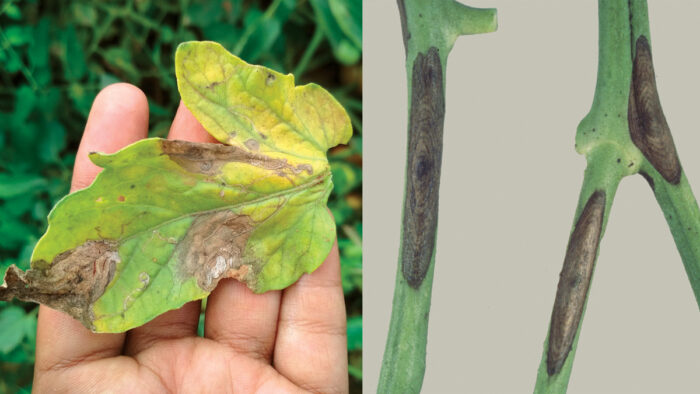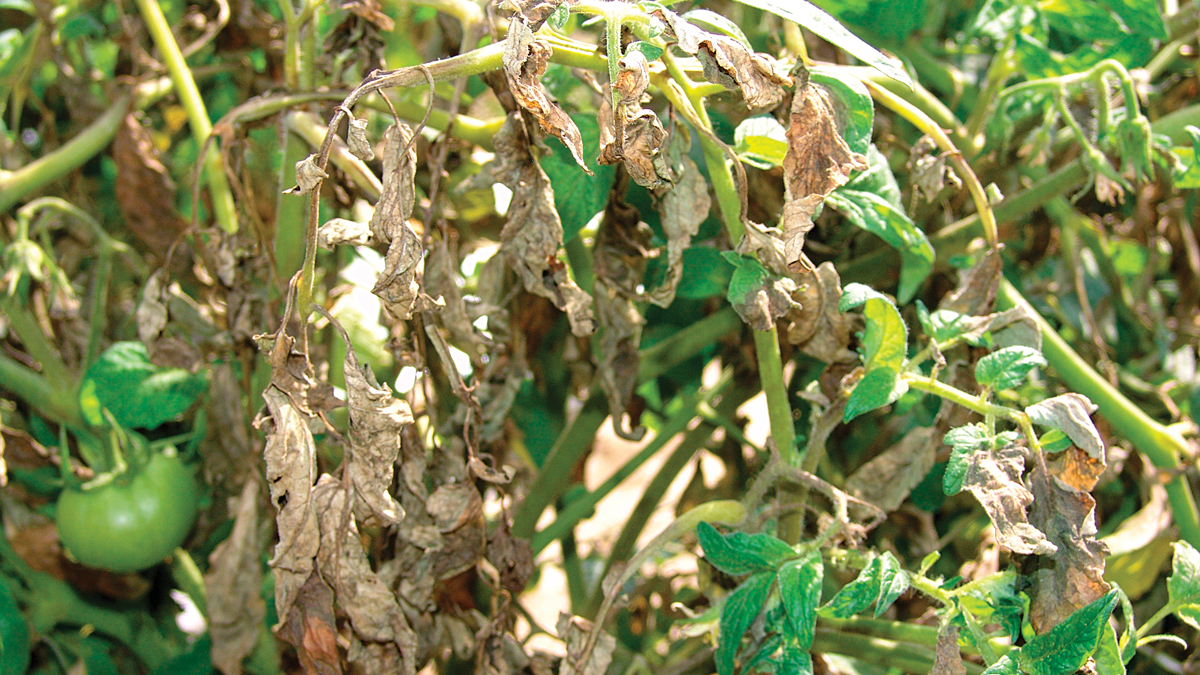
Each year as spring warms into summer, verdant vegetables hold the attention of many an eager gardener. As growers monitor their tomato plants, they may notice scattered yellow spotting, a graying stem lesion, or a few branches wilting suspiciously. Concerned, they ask questions. What usually follows is a circling of sentiments: “Is this blight?” “Definitely blight.” “Better spray it for blight.” “Maybe tomato blight?” And my personal favorite: “It might be blight!”
On the one hand, I am grateful that many people are quick to point in the direction of a plant disease and its management, but too often these conversations end in more confusion. Simply put, tomato blight becomes the catch-all term for myriad pathogens and disorders that affect tomatoes. Adding to the confusion is that there is no single pathogen known as tomato blight. There are actually two very different diseases: early blight and late blight of tomato.
What is early blight?
Usually appearing each summer wherever tomatoes are grown, early blight is quite common. The disease is caused by two species of fungi, Alternaria tomatophila and Alternaria solani. The former is more virulent on tomatoes, while the latter also causes early blight on potatoes. Other solanaceous plants, including eggplant and nightshade weeds, may also show symptoms.
Alternaria spores overwinter on infected plant debris left in the soil, or they arrive in the garden on infected seeds. The spores, called conida, spread to lower stems and foliage by water splash, either from rain or irrigation. If the plant surface remains wet for 5 to 10 hours, spores germinate to infect the plant. The disease thrives in warm summer temperatures, spreading best in the 75° to 85°F range. Since early blight requires a long period of wetness, high humidity plays a key role as well.
Symptoms include circular brown lesions that start very small with a surrounding yellow ring called a chlorotic halo. Spots grow up to half an inch in diameter and often merge as leaves gradually yellow and die. These gray to brown lesions commonly form a bull’s-eye pattern of rings as they expand, a highly characteristic symptom. Lesions also develop on petioles and stems, forming concentric rings if they become large enough. When stem lesions appear near the soil line on young plants, the canker may encircle the whole stem, causing the entire plant to wilt and die. When fruit is infected, black, sunken lesions form next to the calyx (top side).
Infected lesions soon produce spores of their own, capable of spreading farther by wind and rain. If you are quick to observe early blight, removing affected lower foliage and protecting upper foliage with a fungicide can help reduce further spread. It is important to know that symptoms can be very difficult to distinguish from several other tomato diseases, especially Septoria leaf spot.
What is late blight?
It may come as a surprise to learn that late blight is one of the most notorious plant pathogens in history. You may know it by another name—potato late blight. Yes, this is the same organism largely responsible for the great starvation in Ireland in the mid-1840s. Originally from Central America, late blight appeared in the northeastern United States in 1843, spread widely over the next few years, and was carried to Belgium and Ireland, where it wreaked havoc.
Late blight on tomatoes (or potatoes) is caused by the organism Phytophthora infestans. It is not a true fungus but rather an oomycete, in a group of organisms called water molds. The offending organism spreads rapidly in prolonged periods of cool, rainy, humid weather. Uncommon in the home tomato garden, late blight does show up sporadically each season, usually in Pennsylvania, New York, and surrounding states. Visit the USABlight website (usablight.org) each year to learn if it has been reported in your area.

 |
 |
Initial symptoms of late blight are wilting petioles and large, blotchy, light green or water-soaked leaf lesions. Large areas of stem tissue blacken, and whole stems start to collapse. Infected tomatoes may turn brown and leathery, with internal discoloration. In wet weather, infections produce a light, cottony white fungus. Under humid conditions, infected tissue produces spores that are easily moved by wind, rain, or accidental human assistance.
Late blight does not overwinter in the soil of cold climates. It survives on dead plant material, including infected, discarded tomatoes; potato tubers; and other solanaceous plants. Thus, sanitation is critical. With confirmed late blight, all affected plants must be removed and destroyed to prevent further spread. Sending samples to a diagnostic plant pathology clinic at a local university or alerting local extension agents will help monitor annual disease spread.
Whether you are a new or seasoned tomato grower, keep in mind that a lot can go wrong with tomato crops. However, tomato diversity allows for much flexibility. If early or late blight plague your area, choose a resistant variety. If soil nematodes are a key problem, try growing potted tomatoes. If late-season diseases are a problem due to typical regional weather, try early maturing varieties. Use the tools and resources available, and don’t give up! The years that culminate in a delicious yield of juicy tomatoes will be worth it.
| Science |
Best ways to combat tomato diseases
- Identification. To combat a disease, you must know exactly what it is you are combating. Different diseases require different combinations of management strategies. Even for the highly trained eye, diagnosis of most tomato diseases requires laboratory work. Look to a Cooperative Extension–based plant diagnostic clinic, available in most states, for an accurate lab diagnosis.
- Cultural. Most bacterial and fungal diseases (or fungal-like, in the case of late blight) require leaf wetness or humidity to infect and spread. To reduce moisture and increase airflow, consider row orientation with prevailing wind direction, planting in full sun, spacing out plants, and pruning. Also, avoid overhead irrigation, and water early in the day so that the leaves dry quickly if wetted. Mulch around plants to reduce splashing. If disease strikes, you may need to rotate your garden plot to non-solanaceous crops and remove all solanaceous weeds for three to four seasons.
- Nutrition. It should come as little surprise that adequate nutrients play a significant role in keeping tomato plants strong and able to resist infection. However, do not overfertilize, especially with nitrogen and potassium. Have a soil nutrient analysis done every couple of years, and make sure your fertilizers provide what tomatoes need, including micronutrients.
- Sanitation. Start your season with clean, uninfected seeds and seedlings. Make sure to clean tools and equipment after working on infected plants and before working on clean plants in the spring. Remove and destroy all plant residue at the end of the season.
- Sprays. Copper-based organic fungicides provide fair control of early blight in the garden if applied preventively, or if you catch the disease soon after symptoms begin. They are also somewhat useful in preventing late blight, but no product will stop late blight once infection has taken hold.
- Resistance. Planting hybrid tomato varieties with strong resistance to the diseases you battle in your garden is the best way to manage those problems. You may have to interpret some abbreviations. For example, ‘Mountain Magic’ is an indeterminate, early-season cherry type with resistance traits reading V (verticillium wilt), FFF (fusarium wilt races 1, 2, and 3), A (anthracnose), EB (early blight), and LB (late blight).
Matthew Borden, DPM, is a plant health consultant specializing in diagnostics and integrated management of landscape plant pests and diseases.


















Comments
Log in or create an account to post a comment.
Sign up Log in